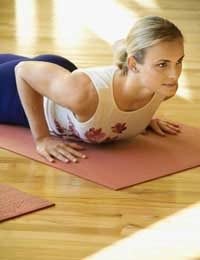
Your back really is one of the workhorses of the human anatomy. Whether its bearing loads bending, stretching or taking the strain of an office where ergonomics doesn’t appear to be in the dictionary, every day brings big challenges. Those challenges are never going to go away, so what you want to do is prepare your back as best you can. By working the muscles in both the upper and lower sections, you will also promote better posture, and this will have a knock-on effect on how the other core areas of your body are handling everyday life.
Let’s start unravelling those knots and stretching your spine by lying flat on the floor, legs slightly apart and out in front of you. Slowly raise your right arm and your left leg out straight, to the same level and hold the position for 5 - 10 seconds before slowly lowering both the floor. Breathe rhythmically for 10 seconds, then repeat the drill with the left arm and the right leg. Aim to complete a series of 10 repetitions over as long a period as it takes. Don’t rush.
Remain Grounded
Initially the action may feel strange and a little unstable, but remember that the two limbs that remain grounded will be providing the stability to execute the drill, so relax, be confident in what you are doing, and keep your neck straight and relaxed.
Remaining flat on your stomach, bring your arms so that your palms are flat to the floor and just in front of the corresponding shoulder. To work on your lower back, push up from the palms so that only the upper body raises off the floor, hold for five seconds, then down, and repeat up to 10 reps.
To work the area around the upper back, stand with the feet a shoulders’ width apart, bend your arms at the elbow so that the backs of the hands are level and facing the top of the shoulders. Make a loose fist and push back with both fists out and around your shoulders so that the arms extend behind the line of the shoulders, thereby squeezing the blade muscles together. Hold for 10 seconds, then return to the original position. Complete 10 reps.
Movements Slow and Steady
Supplement these exercises with some walking and swimming. These extracurricular periods will build on the improved posture that the above drills will promote.
Always remember that although your back feels solid, it is prone to injury, especially as the aging process takes hold. So when exercising or completing floor repetitions, keep your movements slow and steady. Giving your muscles something to think about is one thing, but they’ll quickly tell you when they can do no more. When they do, listen to them. It’s better to cut down on repetitions and continue exercising regularly than succumbing to an injury born of over-enthusiasm.
Don’t forget, too, that stretching exercises are essential before working your back, so some gentle bends from the waist to the floor, hip rotations, marching on the spot while swinging the arms rhythmically, and star jumps will guard against injury. Not only will these routines warm up the muscles but they will also shake loose some of the stress of everyday life that your back soaks up.
Source:- http://www.tonedbody.co.uk/UpperLowerBack.html

